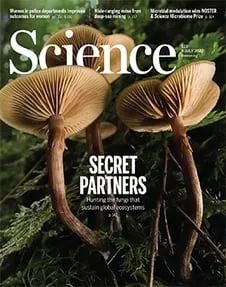"Science" (Published 20220708) One -week thesis Guide
Author:Scientific network Time:2022.07.10
Compilation | Li Yan
Science, 8 jul 2022, VOL 377, Issue 6602
"Science" July 8, 2022, Vol. 377, 6602

Material Science Material Science
High Figure-OF-Merit and Power Generation in High-Entropy Gete-Based Thermoelectrics
High -entropy GETE thermoelectric material high performance and power generation
Author: binbin jiang, wugshixuan liuyan Wang et al.
Link:
https://www.science.org/doi/10.1126/sclence.abq5815
Summary:
By adjusting the localization of electronics and sound, we increase the high value of high -entropy materials based on cymbal -based at 750 to 2.7, and achieve a high experimental conversion efficiency of 13.3%under the temperature difference between 506 Cairvin. By increasing entropy, the increased crystal symmetry makes the electronic distribution in the distorted diamond structure departs the domain, which will cause convergence and improve electrical properties.
In contrast, the inductive local sound -induced LAN inhibits the spread of horizontal sounds, which is the reason for the increase in non -harmonious and the heating rate of the lattice. We provide an example of adjusting electronics and sound -vocalization through entropy operation, while showing a way to improve the performance of high -entropy thermoelectric materials.
Abstract:
By tuning electron and phonon localization, we enhanced the figure-of-merit value to 2.7 at 750 kelvin in germanium telluride–based high-entropy materials and realized a high experimental conversion efficiency of 13.3% at a temperature difference of 506 kelvin with the fabricated segmented module. By increasing the entropy, the increased crystal symmetry delocalized the distribution of electrons in the distorted rhombohedral structure, resulting in band convergence and improved electrical properties. By contrast, the localized phonons from the entropy-induced disorder dampened the propagation of transverse phonons , which was the origin of the increased anharmonicity and largely depressed lattice thermal conductivity. We provide a paradigm for tuning electron and phonon localization by entropy manipulation, but we have also demonstrated a route for improving the performance of high-entropy thermoelectric materials.
A processable, high-performance dielectric elastic elastic
A processable high -performance dielectric elastic body and multi -layer process
Author: Ye Shi, Askounis, Roshan Plamthtomtom Libby et al.
Link:
https://www.science.org/doi/10.1126/sclence.abn0099
Summary:
The dielectric elasticity (DES) can be used as a deformable capacitor to generate mechanical skills under the influence of electric fields. DES is usually based on commercial acrylic and silicone elastomers. Acrylics need to stretch in advance to achieve high -drive response and lack the flexibility of processing. In this work, we synthesize a connected network (PHDE) of designing elastic body, and adjust its electromechanical performance by adjusting the cross -linking network and hydrogen bonds in the crosslinking network. The maximum response of PHDE was 190%. Without pre -stretching, it remained more than 110%at 2Hz.
Abstract:
Dielectric elastomers (DEs) can act as deformable capacitors that generate mechanical work in response to an electric field. DEs are often based on commercial acrylic and silicone elastomers. Acrylics require prestretching to achieve high actuation strains and lack processing flexibility. Silicones allow for processability and rapid response but produce much lower strains. In this work, a processable, high-performance dielectric elastomer (PHDE) with a bimodal network structure is synthesized, and its electromechanical properties are tailored by adjusting cross-linkers and hydrogen bonding within the elastomer network. The PHDE Exhibits a Maximum are strain of 190% And Maintains Strains Higher than 110% at 2 Hertz without Prestretching.
A TWO-PHASE MODEL That Unifies and Extends The Classical Models of Membrane Transport
A two -phase model that can unify and extend the classic membrane transmission model
Author: Varun H. Hegd, Michael F. Doherty and Todd M. Squires
Link:
https://www.science.org/doi/10.1126/sclence.abm7192
Summary:
Two models show how the solvents are transmitted through the expansion -free membrane. The pore flow model based on fluid mechanics is suitable for porous membranes, while the solution diffusion model requires molecular diffusion to handle non -porous membranes.
Both methods have put forward effective arguments for the expansion polymerization film, but they have different stress and concentration distribution in the membrane. We use a streaming model that regards solvent and membrane matrix as a separate phase, and proves that these two classic models are effective in completing the same phenomenon and making the same prediction.
The fluid-solid model shows the measurement of reverse osmosis; consistent with the classic measurement in quantitative, and provides a predictable mechanism basis for experience high-voltage restrictions; s frame.
Abstract:
Two models describe solvent transport through swollen, nonporous membranes. The pore-flow model, based on fluid mechanics, works for porous membranes, whereas the solution-diffusion model invokes molecular diffusion to treat nonporous membranes. Both approaches make valid arguments for swollen polymer membranes , but they disagree in their predictions of intramembrane pressure and concentration profiles. Using a fluid-solid model that treats the solvent and membrane matrix as separate phases, we show both classical models to be valid, to represent complementary approaches to the same phenomenon, and to make identical predictions. The fluid-solid model clarifies recent reverse osmosis measurements; provides a predictive and mechanistic basis for empirical high-pressure limiting flux phenomena, in quantitative agreement with classic measurements; and gives a framework to treat nonporous but mechanically heterogeneous membrane materials . Chemical Chemistry
Maximizing Noble Metal Utilization in Solid Catalysts by Control of Nanoparticle Location
By controlling the position of nanoparticles, the utilization rate of maximizing precious metals in solid catalysts
Author: Kang Cheng, C. J. Smulders, Lars I. Van der Wal et al.
Link:
https://www.science.org/doi/10.1126/sclence.abn8289
Summary:
Maximizing the utilization of precious metals is essential for catalytic applications. We found that by rationally arranging function sites at the nano -scale, the minimum platinum load required for the hydrogenation of industrial dual -function catalysts can be reduced by 10 times or more.
It is interested in the traces of the aluminum binder or the outer outer of the amproof rather than the surface of the surface of the platinum nanoparticles in the inner surface of the burpestone, which can enhance the selectivity of the same differences without affecting activity.
The separation between platinum and boilic acid positions can maintain metal and acid functions by restricting the blockage of micropores and enhanced the entry of metal sites by restricting metal clusters. The restored platinum particles are more active than the combined platinum single atom.
Abstract:
Maximizing the utilization of noble metals is crucial for applications such as catalysis. We found that the minimum loading of platinum for optimal performance in the hydroconversion of n-alkanes for industrially relevant bifunctional catalysts could be reduced by a factor of 10 or more through the rational arranging of functional sites at the nanoscale. Intentionally depositing traces of platinum nanoparticles on the alumina binder or the outer surface of zeolite crystals, instead of inside the zeolite crystals, enhanced isomer selectivity without compromising activity. Separation between platinum and zeolite acid sites preserved the metal and acid functions by limiting micropore blockage by metal clusters and enhancing access to metal sites. Reduced platinum nanoparticles were more active than platinum single atoms strongly bonded to the alumina binder.古生物学Paleontology
UltraStructure Reveals Ancestral VerteBrate Pharyngeal Skeleton in Yunnanozoans
Ultra -micro -structure reveals the vertebrate pharyngeal bone in Yunnan worms
Author: qingyi tian, fangchen zhao, han zng et al.
Link:
https://www.science.org/doi/10.1126/sclence.abm2708
Summary:
The pharyngeal bow may help the brain of evolutionary jaw and vertebrate, which is a key evolutionary innovation. For a long time, people have been assumed that the ancestors of vertebrates (such as non -vertebrate Wenchang fish) and pharyngeal bow (gills) have evolved from a cartilage without joints, but whether this ancestor anatomy exists is still unknown whether it is unknown Essence
There are controversial Cambrian animals, Yunnan worms, and their pharyngeal bone may contain the oldest evidence of the early evolution of these bows, but its correlation with vertebrates is still unknown. By using new technologies (for example, X -ray microscopy scanning, scanning and transmitting electron microscope, and energy color scattered spectrum elements) are checked, we find that the gill bow of Yunnan worms consists of cell cartilage, and extracellular matrix is dominated by micro -original fiber -led led This is considered to be the unique feature of vertebrates. Our systematic development analysis further proves that Yunnan worms are vertebrates.
Abstract:
Pharyngeal arches are a key innovation that likely contributed to the evolution of the jaws and braincase of vertebrates. It has long been hypothesized that the pharyngeal (branchial) arch evolved from an unjointed cartilaginous rod in vertebrate ancestors such as that in the nonvertebrate chordate amphioxus, but whether such ancestral anatomy existed remains unknown. The pharyngeal skeleton of controversial Cambrian animals called yunnanozoans may contain the oldest fossil evidence constraining the early evolution of the arches, yet its correlation with that of vertebrates is still disputed. By examining additional specimens in previously unexplored techniques (for example, x-ray microtomography, scanning and transmission electron microscopy, and energy dispersive spectrometry element mapping), we found evidence that yunnanozoan branchial arches consist of cellular cartilage with an extracellular matrix dominated by microfibrils, a feature hitherto considered specific to vertebrates Then, then, then Our Phylogenetic Analysis Provides fresher Support that yunnanozoans are st pokbrates. Edit | Fangyuan
Capture | Guo Gang
Cooperation: [email protected]
Submission: [email protected]
Like this article? Praise + watch support!



- END -
Hui eye satellite refresh the strongest magnetic field record of the universe

The neutron star is the celestial body with the strongest magnetic field in the un...
Yuanwang No. 5 sail!

On the morning of July 13, the third -generation aerospace ocean measurement ship ...